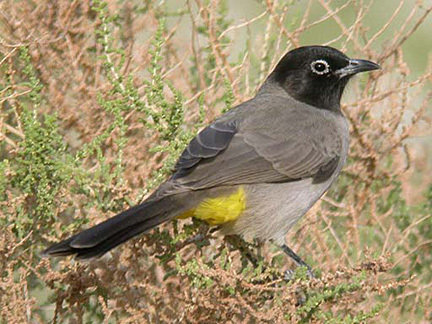
White-spectacled Bulbul
The White-spectacled Bulbul (*Pycnonotus xanthopygos*) is a member of the bulbul family, commonly found across a variety of habitats in the Middle East and parts of the Arabian Peninsula. It's a highly adaptable species, thriving in both natural and human-modified environments. Ecologically, it plays a role in seed dispersal and insect control. While not globally threatened, its presence is an indicator of ecosystem health in its native range. It is not particularly significant culturally but is a familiar and easily recognized bird in its region.
18-21 cm
Length
20-25 cm
Wingspan
Least Concern
Conservation Status
Distribution
The White-spectacled Bulbul is found in the Middle East, including Lebanon, Syria, Jordan, Israel, Palestine, Saudi Arabia, and parts of the Arabian Peninsula. It has a relatively restricted range, primarily within these regions. No significant migratory patterns are observed; it is largely a resident species.
Lifespan
Unknown in the wild, potentially 5-10 years based on similar bulbul species.
White-spectacled Bulbul's Habitat
Habitat Types
Mediterranean woodlands, Shrublands, Oases, Gardens, Agricultural areas, Urban parks
Climate Zones
Mediterranean, Semi-arid
Adaptations
This species is highly adaptable to varied food sources and nesting locations, enabling it to thrive in both natural and human-altered landscapes. It can tolerate relatively dry conditions.
Variations
While some regional variations in plumage might exist, there are no widely recognized subspecies.
Appearance
Breeding Plumage
No significant difference between breeding and non-breeding plumage.
Seasonal Feather Changes
Minimal seasonal variations.
Sex Based Plumage Differences
Males and females have very similar plumage.
Notable Features
Distinctive white ring around the eye (the 'spectacles')., Black head and throat., Yellow vent (undertail coverts)., Greyish-brown upperparts and paler underparts.
Diet and Feeding
Primary Foods
Fruits, Berries, Insects, Nectar
Foraging Behavior
Forages actively in trees and shrubs, often in small groups. It gleans insects from foliage and readily takes fruit.
Specializations
No highly specialized feeding adaptations, reflecting its generalist diet.
Seasonal Diet Variations
Diet may shift seasonally depending on fruit and insect availability. More insects may be consumed during the breeding season to feed young.
Behavior
Social Structure
Often found in pairs or small family groups. May form larger flocks outside the breeding season.
Communication
Loud, chattering calls., A variety of whistles and trills., Visual displays, such as raising the head feathers.
Migration
Largely non-migratory, although some local movements may occur in response to food availability.
Territorial or Group Behaviors
Territorial during the breeding season, defending nesting sites. Otherwise, relatively social.
Conservation
Threats
Habitat loss due to agriculture and urbanization., Pesticide use in some areas.
Protection Programs
None specifically targeted at this species, but general habitat conservation efforts benefit it.
Local National Laws
Protected under general wildlife protection laws in some countries within its range.
Population Trend
Stable
Population Estimates
Not Evaluated
Interesting Facts
The 'spectacles' give it a perpetually surprised expression.
The white eye-ring is a defining characteristic that easily distinguishes it from other bulbuls.
They are known for their bold and sometimes noisy behavior.
They are often seen and heard in gardens and parks, unafraid of human presence.
Its scientific name, *xanthopygos*, refers to its yellow vent.
The name combines Greek words 'xanthos' (yellow) and 'pygos' (rump).
Faqs about White-spectacled Bulbul
Are White-spectacled Bulbuls good pets?
No, they are wild birds and are not suitable as pets. They require a varied diet and specific environmental conditions that are difficult to replicate in captivity. It is also illegal to keep them as pets in many areas.
What is the best way to attract White-spectacled Bulbuls to my garden?
Planting native fruit-bearing trees and shrubs can attract them. Providing a source of water, such as a birdbath, can also be helpful.
Do they damage crops?
While they consume fruit, they also eat insects, which can benefit agriculture. Significant crop damage is not typically reported.
How can I tell the difference between a male and a female?
It's very difficult to distinguish between males and females based on appearance alone. Their plumage is almost identical.
Copyright @ Nature Style Limited. All Rights Reserved.
 English
English